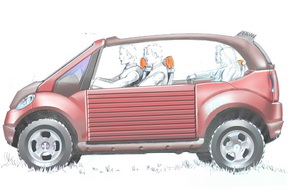Original URL: https://www.theregister.com/2008/02/14/air_car_tata_deal_imminent_breakthrough_foretold/
Inventor promises bottle-o-wind car in a year. Again
French hot-air jalopy gets Indian backing
Posted in Science, 14th February 2008 15:44 GMT
French inventor Guy Negre, who has promoted his plan for air-powered cars for decades without significant success, says he has finally secured backing from a major motor manufacturer. Negre's small family design firm MDI has announced a partnership agreement with Indian car giant Tata, and excited reports have it that air-driven cars could be on sale within a year.
Negre himself is slightly more circumspect, merely saying that he "is happy to conclude this agreement with Tata Motors and work together... to develop a new and cost-saving technology for various applications for the Indian market..."

MDI OneCAT: blowing hot and cold for years now ...
The Beeb's environmental-issues people, however, tell us that Negre "has promised that within a year he will start selling a car". This would be sales in France direct from MDI; Tata has not gone firm on any production plans.
The current iteration of the air car seems to be a five-seater variant on the OneCAT designs described on MDI's website. The car uses compressed air from carbon-fibre tanks to drive a piston engine. The specs for a six-seater job claim 22 cv power (French cheval-vapeur metric horsepower units, a trifle smaller than brake horsepower). The new OneCAT should weigh 350kg, according to the Beeb, so the power-to-weight ratio comes out only a little less than that of a Fiat Panda.
That said, the OneCAT is less than half as heavy as a Panda, so it will be much more adversely affected by the weight of passengers and baggage. Even so, assuming the power figures are for real, the quoted top speed of 100km/h seems reasonable.
Negre also reckons the car could go 100km on a single charge of air. The Beeb says that such a charge can be delivered by a "compressor" in just a few minutes, which is true - you'd be talking about a big 300kW/400 horsepower job at least, though, an expensive four or five tonne piece of kit. In the video report, the MDI people actually seem to be using an air bank, which would be cheaper and simpler.
OneCAT drivers lacking an industrial compressor or air bank would need to plug in the car's little electric onboard compressor, which can fill it in four hours. A slow charge like this would be a good bit more efficient, actually, as the storage tanks wouldn't get so hot. Any diver who has spent a lot of time charging up air bottles knows that the faster you do it, the hotter the air gets. As it then cools down to ambient temperature, much of the pressure you thought you had dies away.
So the air car's main advantage over battery vehicles - the quick charging - may not be quite all it seems. The heating effect also means that air compressors waste a lot of the energy you use to drive them, because they get very hot.
And that isn't everything. The most doubtful item about the air car is the claimed 100km range - and indeed Negre admits there is still a good deal of work to be done here. That figure in particular should probably be treated much as one might treat a cellphone endurance claim; with a large pinch of salt.
Doubts as to the claimed range are enhanced by the fact that MDI has made a major effort of late to enhance the OneCAT's endurance. Unfortunately, it has done so by sacrificing the engine's zero-emissions status. A burner has been added which heats up the air between tanks and engine, boosting the pressure a bit and so ekeing out the supplies. This burner can apparently be fuelled by small amounts of almost any liquid fuel; and when running in this hotter-air mode, Negre claims 800km range on a pressure charge.
All in all, there seems no real reason to think that Negre will really meet this delivery forecast any more than he has met any of his previous ones. Some speculative money from Tata doesn't really seem likely to suddenly whip the air car into shape.
But let's assume it's really true this time, and the hot-air car isn't just a lot of hot air.
"The first buyers will be people who care about the environment," according to Negre.
Well, maybe. Compressed air, like so many alternative-motoring technologies, doesn't solve the issue of generating power without carbon emissions - especially given the need for burner boost. The air car, like an electric or hydrogen vehicle, merely moves the power generation offboard and into a stationary infrastructure.
In France, to be sure, you can use grid power which comes mostly from nuclear generators and thus is nearly carbon-free. But an awful lot of people who see themselves as caring about the environment will have nothing to do with nuclear power.
Away from France or Switzerland, the air car would be essentially a very inefficient fossil-fuelled one; wasting energy unnecessarily in electricity generation/transmission in all likelihood and at the compressor for certain. It would make more sense in terms of carbon emissions to just burn the fossil fuel on board in a conventional small car: you'd use less overall.
So the hot-air car isn't just unlikely to succeed, it also seems fairly pointless in most markets and strictly limited-appeal even in France. But in some future world where grid energy is cheap and clean - and the air car's specs are reality - it might carve a niche. Assuming that hydrogen, fast-charge batteries, or onboard carbon capture don't work out, anyway.®